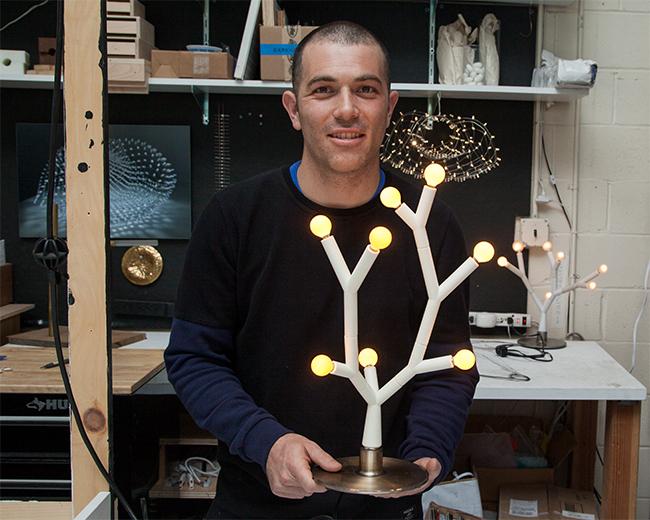
Splyt Light Designer Jason Krugman in his Brooklyn studio, photos by Rachel Orlow
There’s an exciting energy that runs through Jason Krugman’s workspace in the New Lab at the Brooklyn Navy Yard. The open, industrial space fosters cross-pollination of ideas in an environment where science, technology, invention, and art meet. Nearby, an experimental collaborative of architects works on design and material concepts that seem drawn from science fiction—from mushroom bricks to human shelters made from cricket colonies. In the midst of this fantastic innovation, Jason and his partner, Scott Leinweber, created the Splyt Light, an innovative new lighting design that lets consumers build their own unique fixture from a kit of modular parts. We visited Jason’s light-filled space for a look at where Splyt was born, and a conversation about his work sculpting with light and finding ways to share that exhilarating experience with others.
What were some of the inspirations for the Splyt Light design?
I met Scott, who founded Splyt with me, through a public art project we both worked on. When we were taking a break at lunch in this diner, there were these really cool, branching lights using off-the-shelf splitters from the hardware store. And for a long time, I had been trying to figure out a way to make an affordable, modular system that I could sell as a product so that people could make cool, sculptural light fixtures on their own for their space. So I knew it had to be simple but robust, and use as many off-the-shelf parts as possible. Those rules helped me think about what this new thing might be, but up until that moment I hadn’t really thought of doing it in this way. There were always too many custom things; what I was trying to come up with was too elaborate. So it was kind of an epiphany to say: why don’t we just take that idea and optimize it? Optimize it so that it’s more beautiful, so it’s arranged better in the space, and it’s more versatile for doing the things that people need it to do. And it had to be scalable so people could make a reasonably sized and interesting thing and be able to expand upon it.
Was there anything else from your own work or from existing products that provided inspiration for the design?
Modularity was one of the initial rules that I had in my head about what it had to be. I essentially developed these material vocabularies by going to lighting stores and looking at every connector and product they have, and thinking about how I could develop a system with those items. So often, I’m trying to come up with a system but those systems have to be modular in some way so they’re scalable. Thinking of it from an evolutionary perspective, if this thing makes sense and it’s well designed, then I should be able to grow it and expand upon it and embellish it to do more and more interesting things. But if it doesn’t, then it’s on to the next, and I can iterate and choose a design that way. So the idea of working modularly was square one, and something that repeats itself through all the stuff that I do.
I noticed you’re using words like growth and evolution. Is there any inspiration in the geometry and forms here from nature?
Definitely. From my background in liberal arts and my studying and reading about economics (my undergraduate major) and Darwinism and capitalism…and memes…and how those things all intertwine with each other. I think in modern society, if you can delve into those things, it goes to the basis of artificial intelligence, and to the way plants grow in a given space—they way that things branch off. And also if you have a lot of power going through a system and you look at the way the wiring works, it looks like a tree: you’ve got a trunk that all the power has to go through in the beginning, then it gradually forks and tendrils out until you get to the tiniest little element that needs to receive electricity.
That tree structure is really a fundamental, natural structure, and it makes sense in terms of physics, in terms of electronics, and in terms of mechanical form. So that provided a lot of inspiration in figuring out what kind of a system we could use that was based on an existing vocabulary already familiar to people. And saying that it had to be a standard screw size socket so that it could be interchangeable and so that it can seamless integrate and be used creatively. There’s a reason that we made two out of the three components asymmetrical, so that all the bulbs wouldn’t end up in the same place. We wanted to make something that looked more like a tree and less like a pure algorithm.
Tell us more about this space—how does it inspire your work?
This space evolved from a collective of artists who were in this other amazing building in downtown Brooklyn called the Metropolitan Exchange building—the group of artists, inventors, and thinkers who were there were this incredible community, always in flux, with more and more people coming. And at a certain point, there was this exodus of a bunch of people who left there to come over here to start this new community called New Lab. It’s been this partnership between the NYC Economic Development Corporation and a real estate developer who does a lot of interesting architectural interventions, focusing on maker spaces and creative spaces. The old space was called Dark Matter Manufacturing (DAMM) and this is “DAMM Navy,” but it’s also the New Lab…a sort of co-working space where people are making physical stuff—prototyping physical things, but also working with data and the web and 3D printing. It’s kind of like an incubator, but it’s kind of like a symbiotic community of people who are generally pretty forward-thinking, working with new materials, new manufacturing and design techniques to make different products, installations, and architecture.
It’s definitely heaven for me in terms of a studio space, so I’m really happy that I’ve been able to grow and become part of this space. It’s wonderful how open it is, because traditional artists’ studios were in the space that nobody wants…and that’s what my studio used to be. So I’m really happy to have this well-lit, open space with lots of people around me. It was a big point to not build up to the ceiling or stack things up to the ceiling. And people are pretty tolerant overall of sharing workspace.
Tell us about your work here beyond developing Splyt Light
I make new systems for making LED artwork and light fixtures. My mantra is to try to arrange light and electricity within three-dimensional space in new ways, to come up with systems that allow me to design things that were previously un-doable, both from an aesthetic and from a technical sense. A lot of what I’m trying to do is get rid of all the extra material and pare things down to the minimal elements…we really respond—perceptually and emotionally—to light, to seeing moving lights and lights in space…and so I’m trying to figure out new and original ways to arrange lights in space to keep things minimal and interesting, playful, integrating a lot of the forms and design work that nature has already done into the structures that I’m making.
Do you consider light a sort of material?
No, I don’t think light is a material…it’s interesting in that it’s energy and it’s information. There’s a ton to know about the science of light. But LEDs as a medium are incredible because they allow you to build and design in ways that you couldn’t have earlier. Because they’re so efficient and because they’re so versatile…the color that they can provide…they can be decorative or they can provide functional light…they’re attainable to a small inventor / artist / studio like me. And at a certain point, I realized that not that many people were working with them as a material. LEDs are cost-effective and there are a lot of elements in relation to designing with them that you can do yourself. There’s a huge, fertile, creative terrain based around using LEDs as a medium. You could use light as a medium, but I don’t think I’m using just light as a medium. I’m more using the LED and the light source and all the materials associated with making those things work. That’s my creative palette.
What were some of your inspirations to venture into a consumer product?
It’s really about allowing people to have beautiful objects in their own spaces that they’ve had input on—not just something that you pull out of the box and it’s done. But also on the flipside, not something that’s so complicated that you become frustrated. So something that’s interactive, but simple enough so that it’s attainable.
What’s your vision for how the Splyt system can expand to add complexity or functionality?
One thing that I can’t wait to see is for other designers to take this and use it to make whole spaces. So for example, you could do a beautiful design for a restaurant by having lots of screw sockets interspersed on the ceiling, with lots of Splyt lights of different sizes and formations coming out of all of them. Basically creating this textural field using this product—almost like a coral reef. If nobody else does it, I’m gonna do it! But hopefully, others will too.
What are some of the differences between making your artwork and making a product like this?
To be honest, I think the processes are similar. But with making a commercial product it’s much more intense and rigorous. Everything gets analyzed on the micro scale, over and over again. That’s the same with the artwork that I make, but with my art, I’m able to adjust it on the fly, one thing at a time. Whereas with product, at some point you have to let it go and it goes out into the world with many, many units. I guess it’s the same with artwork (you have to let it go), but there’s less opportunity for hand tuning and adjustment.
Do your custom installations provide a bridge between these worlds?
Yeah. I don’t have a gallery that represents me (though I’ve shown in a couple museums and galleries in the past), but mainly my practice is doing site-specific installations for public space and residential spaces. I just did a commission for a large cruise line—I built a 20-foot tall brass and LED sculpture for them. I also did a large, interactive LED installation for a social club in Midtown Manhattan called Interface.
What are your essential tools?
For me, the soldering iron is key for making the material (LED grids). The other tool that’s essential to what I do is the laser cutter. I have a tool—basically a jig—that I use to make this LED grid material. It’s a sheet of Plexiglas that allows me to pop the LEDs into little holes and get the spacing to be perfect. After that, it’s just folding all the LEDs and soldering them into place. I also make my own specialized tools. So that’s a big piece of what I do—coming up with these custom tools for specific purposes.
The 3D printer was really important to making Splyt. We 3D printed hundreds of these things out of nylon. We did a lot of prototyping, figuring out what a lot of different finishes would look like, how they might fit together, and testing all different sizes.
What are some of the hardest lessons you’ve learned in the course of launching Splyt?
One of them is patience. Even though we have a great manufacturer for Splyt and everything’s going well, it just takes a very long time to bring a product to market…because all of the set up you have to do anticipating that you’re going to be selling a lot. So everything has to be very rigorous, well made, and well documented. Working with a large team and communicating to get everything perfect takes a long time, even in the best-case scenarios. I’ve learned that, in order to do things the right way, you have to pay attention to the details.
How did you and Scott collaborate on making the Splyt Light?
He’s an expert at design for manufacturing and working with software to deal with 3D data, and either fabricating physical things out of it or creating visualizations that are relevant for architecture or construction. He’s done a wide variety of things: he built his own teaching website to help other people learn 3D modeling software, and he’s really interested in the intersections of these new ways of making things using computers, 3D modeling, and rapid prototyping in comparison with traditional crafts and traditional ways of building and prototyping—for industrial design, artwork, and architecture. So he’s been a crucial and amazing partner for me in designing Splyt, because of his knowledge in relation to the design process.
We met in 2012 working on a public art project in Bethesda, Maryland and we bonded over a common taste in light objects and aesthetics and it was an obvious relationship that made a lot of sense for us to work together—because we had similar aesthetic and design goals, plus complimentary skills.
How do you set goals for yourself?
Our goal is to make something that will take on a life of its own and will live out in the world, kind of as its own animal. To have something that’s a good idea that people like, that makes sense economically, that becomes ubiquitous because of that. So like an Internet meme—something that propagates because of its characteristics. To make something that grows and doesn’t require us to push it every step of the way—that’s the goal for this.
How do you like to celebrate success?
One of the things I really love is gorgeous images of things that I’ve made—kind of from a metaphysical standpoint, just to create that moment in time, and to record it, and be able to own it. To say I made this; I’m proud of this; I created this at this moment in time. That’s the most rewarding thing about it. Other than just being able to continue to do this and to interact with other interesting people who are coming up with ideas and going through the same process. One of my biggest shortcomings is not taking enough time to say ok, that went really well—let’s just enjoy it for a little while. Because I’m so excited by all of the ideas that I haven’t realized yet, that I’m always pushing to keep things rolling and to keep pushing the designs forward.
How do you recharge your creativity?
I go hiking. I try to bike to work. Being outdoors. I really love Wave Hill—it’s so beautiful, they have the nicest greenhouses—one that has jungle plants and cacti—and then there’s an amazing outdoor rock garden they have that’s more of an alpine greenhouse. Just the selection of flowers and plant species is so gorgeous and inspiring. It’s nice because it’s kind of quaint and small. So that for me is a really nice creative retreat and reward for myself to wander around and look at those things.
Given the array of influences on the Splyt Light and Jason’s other light sculptures, I wasn’t surprised that he wrapped up the visit by telling us about a piece that I had been admiring since we arrived—a grid of LED lights with soft, glowing coverings. Jason explained that they were actually silkworm cocoons which softened the bright, bluish harshness of the LEDs, and were the perfect size for the LED grid he works with. This blend of natural and technological systems seemed a perfect companion to the Splyt Light—the amazing architecture of nature applied to functional design.

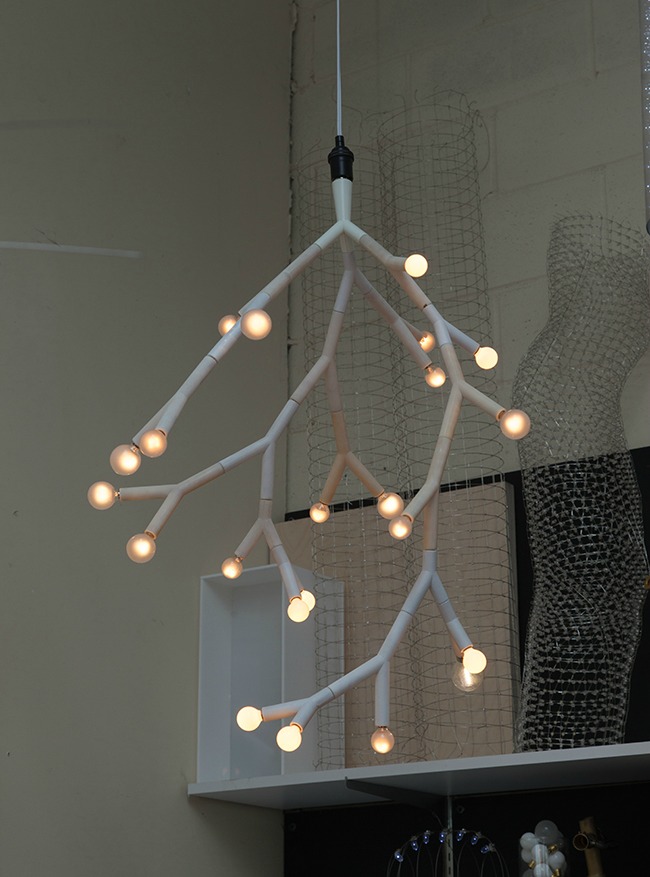
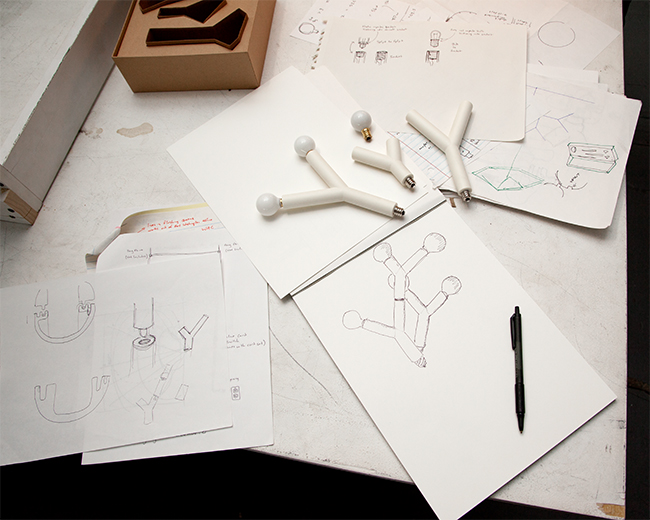
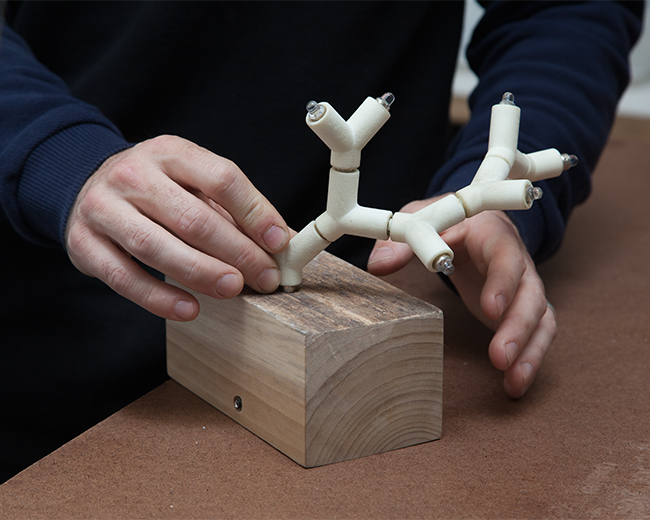
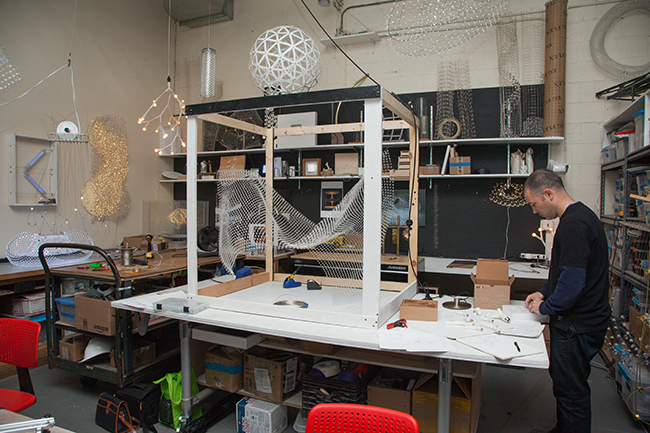
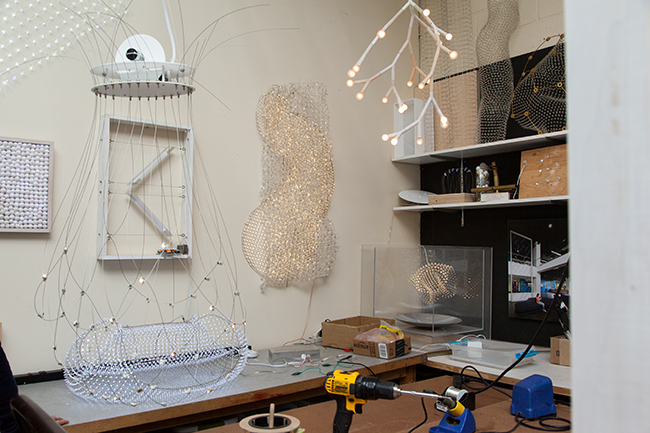
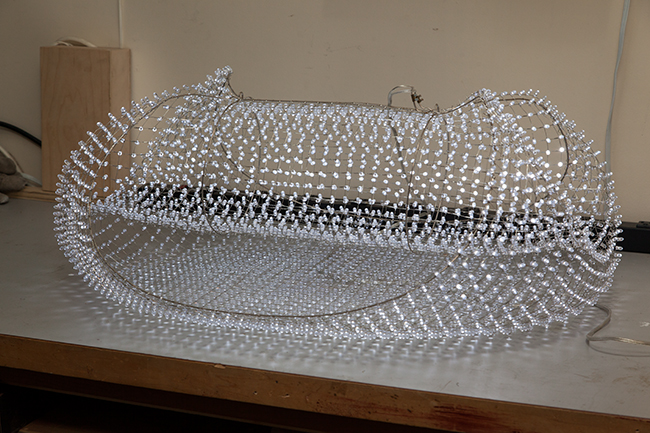
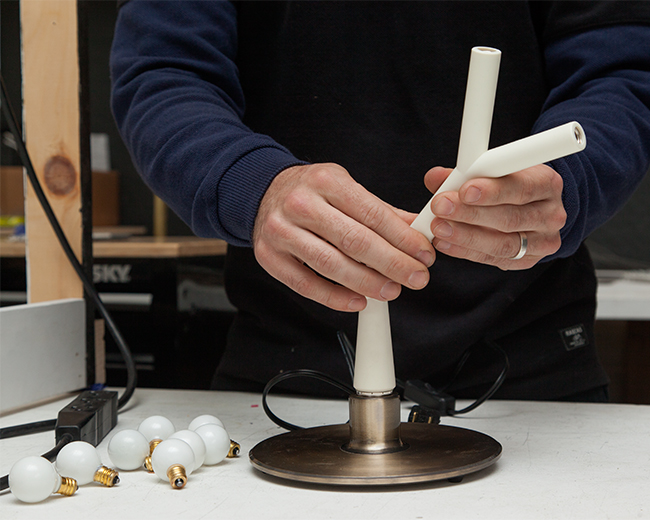
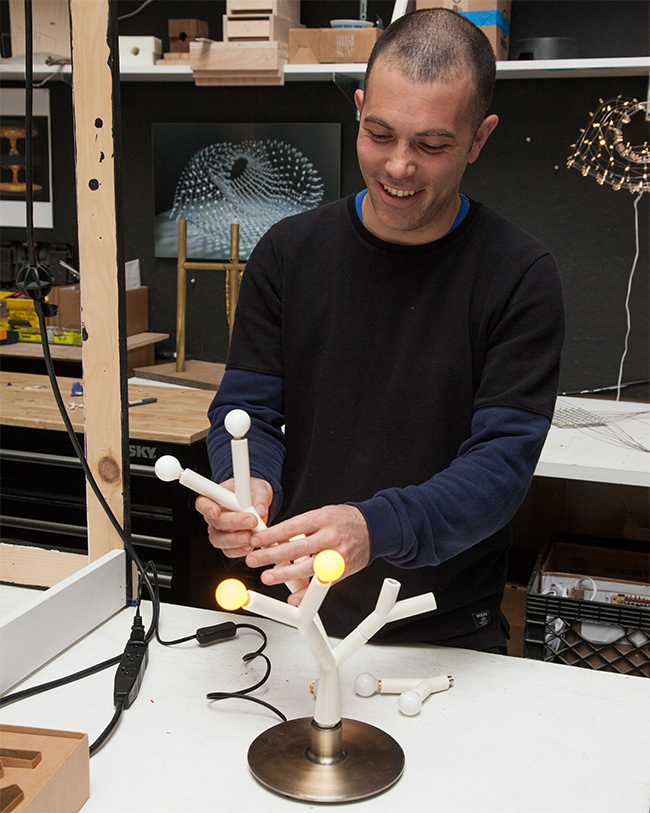
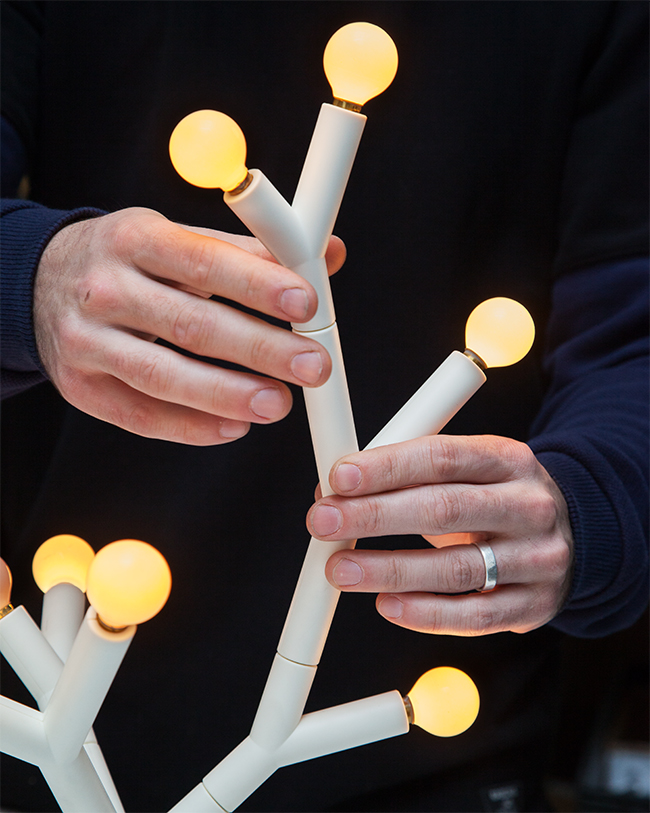
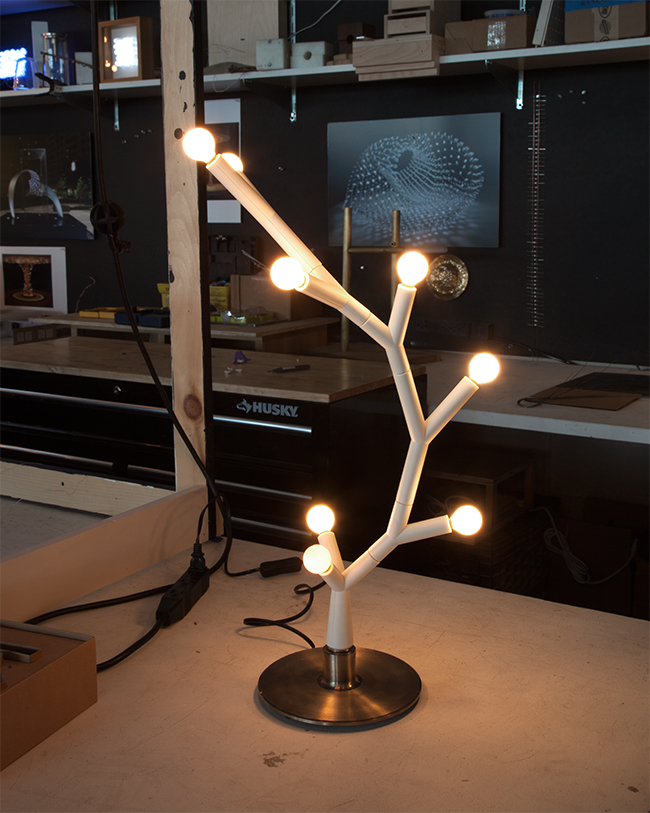
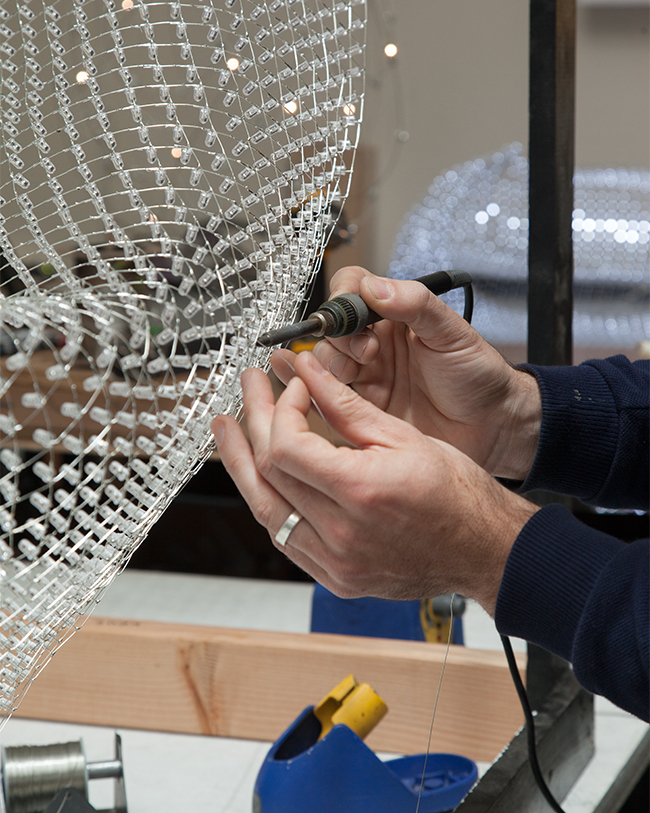
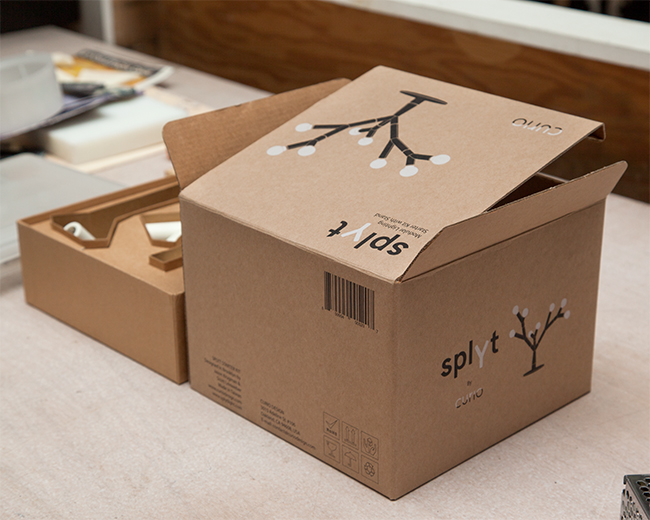
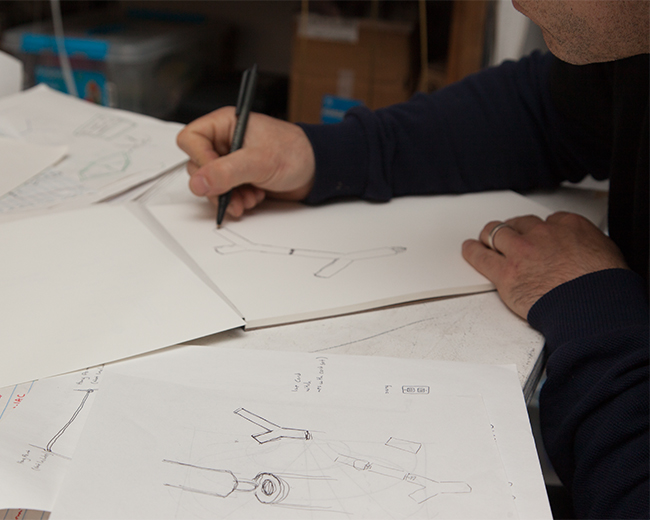
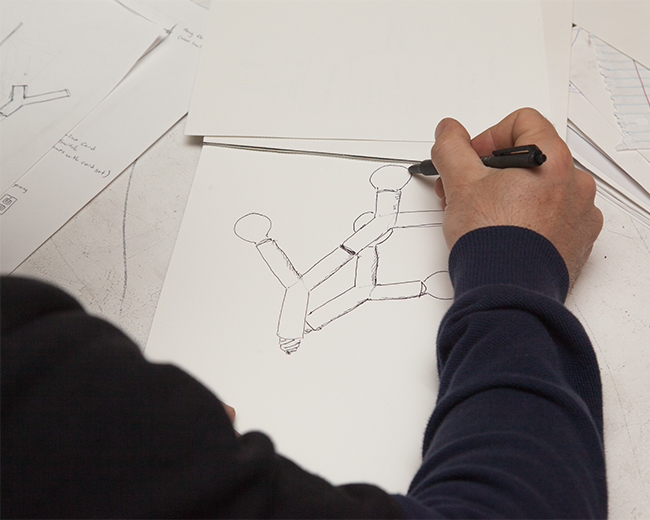
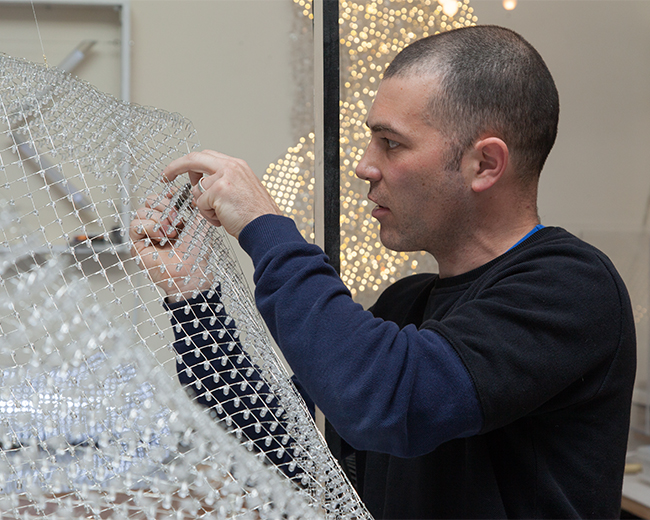
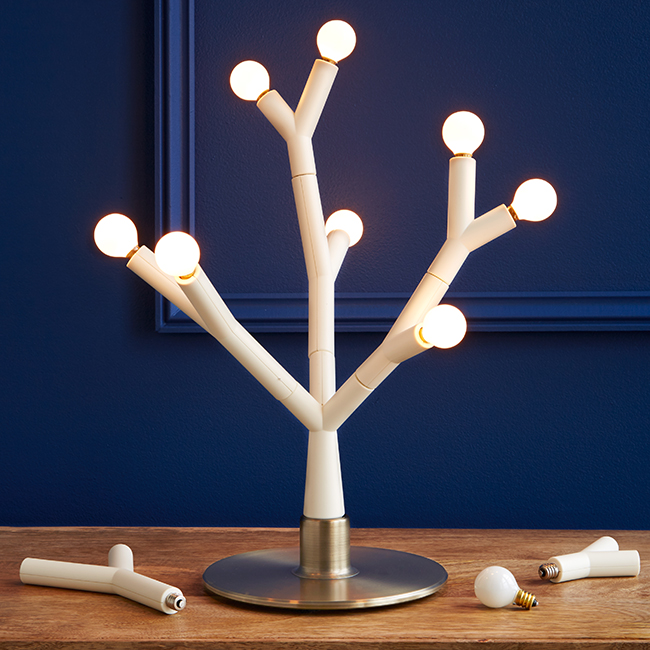
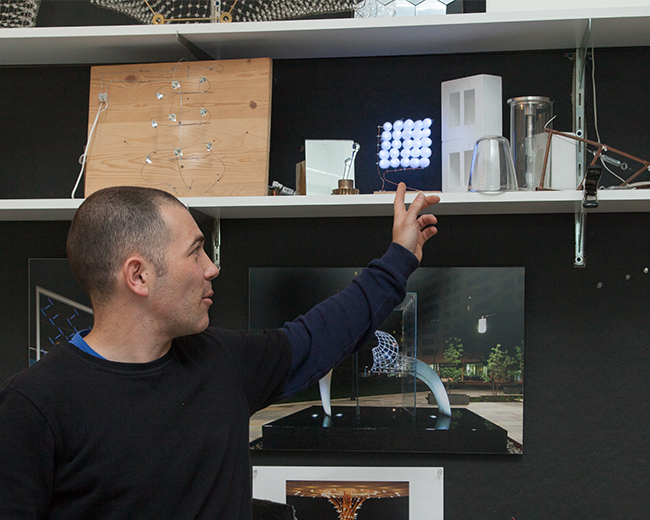

1 Comment
[…] So I settled in for a nice thorough browse of the men’s sections of Uncommon Goods. I immediately felt good at the prospect of choosing something from this place. Their mission is to make sustainability part of every decision they make, and seem conscientious about being environmentally friendly, socially responsible and a rewarding place to work, to boot. They folks at Uncommon Goods search out the unusual, too, which I like. You can read more about some of their artisans on their blog here. […]